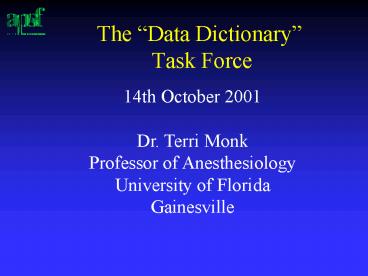The Data Dictionary Task Force - PowerPoint PPT Presentation
1 / 18
Title:
The Data Dictionary Task Force
Description:
Demonstrate leadership in outcomes research in anesthesia by improving patient safety ... database that could have long-term value for APSF and anesthesia community ... – PowerPoint PPT presentation
Number of Views:50
Avg rating:3.0/5.0
Title: The Data Dictionary Task Force
1
The Data Dictionary Task Force
14th October 2001 Dr. Terri Monk Professor of
Anesthesiology University of Florida Gainesville
2
Todays Goals
- Present the Project Plan Approved by APSF
- Describe the Link between Outcomes Research and a
Data Dictionary or Reference Data Set - Present Technical Working Group Plan
- Seek Feedback from Meeting Participants
- Establish a Timeframe for Action
- Secure Commitment within 30 Days
3
The APSFs Commitment
Endorse and advocate the use of automated record
keeping in the perioperative period and the
subsequent retrieval and analysis of the data to
improve patient safety
4
Authorization of the Task Force
The APSF has agreed to support the Data
Dictionary Task Force by contributing 25,000 in
seed funding
5
Task Force Objectives
- To Identify a Minimum Set of Data Elements for an
Electronic Anesthesia Record and Subsequent
Outcomes Research - To Develop and Conduct Outcomes Research Projects
to Validate Anesthesia Information Management
Systems (AIMS)
6
Data Dictionary Task Force
- APSF Executive Board
- financial control
- guidance and direction
- Task Force Chair
- organizational control
- project reporting
- Informatics Expert
- technical direction
- tools construction
- Task Force
- clinical review
- minimum data set
- Technical Working Group
- data submission
- technical support
7
Task Force Budget
Total Budget Year 1 (Oct. 2001-Oct.
2002) 162,000 25,000 APSF Contribution 137,00
0 Industry Contribution 6 contributors
22,800 5 contributors 27,400 4 contributors
34,250 3 contributors 45,600
8
Task Force Deliverables Year 1
- Tools to Compile Reference Set
- Reference Set of Data Elements (aka the Data
Dictionary)
9
Data Submission and Review
Development of Data Submission Tools
Review of Existing Lexicons and Population of
Preliminary Reference Set
Data Element Submission
Reference Set Clean up and Validation
Clinical Review for Set Completeness
First Draft Publication. Review by Technical
Group
Review of any public comment. Development of
final document for publication on APSF web site
Publication of draft data dictionary for public
comment
Revision Cycle
10
Clinical Outcomes Research and the Data
Dictionary
- Cornerstone of outcomes research
- Needed to credibly compare data between
institutions - Lack of standardized data collection techniques
barrier to data aggregation and analysis both
within and among institutions - Lack of common data set not cost-effective for
product development and implementation
11
Outcomes Research Supported by a Reference Data
Set
- How could AIMS improve patient outcomes?
- - Lessons learned from Computerized Physician
Order Entry - Is data capture under AIMS more accurate than
that under manual systems? - Does the use of AIMS modify clinician behavior?
- Can pilot studies be designed that credibly
compare manual vs. automated systems across
institutions?
12
Outcomes Research Supported by a Reference Data
Set
- How does AIMS aid root cause analysis for
systemic error identification and prevention? - Can a pilot study be designed to investigate link
between handwritten records, medical errors, and
improvements due to computerized record? - Does AIMS prevent medication errors due to pick
lists and standardized content?
13
Outcomes Research Objectives
- Investigate protocol development
- Investigate external funding sources for research
- Develop grant proposals to secure future funding
(1 year out)
14
Outcomes Research Objectives
15
Clinical and Technical Expertise
Outcomes Research Monk Beattie Caplan Fleisher New
land Reves Worth Expert clinical review,
outcomes research focus, research agenda
development, and consensus development
Data Dictionary Sanderson Representatives Agilent
/Philips Deio/Datex Draeger eko GE iPath Picis Sie
mens etc. Technical expertise, financial support,
data element submission and standardization
Link between clinical problem solving, outcomes
research, and product development
16
Benefits of Task Force Plan
- Demonstrate leadership in outcomes research in
anesthesia by improving patient safety - Reference data set is fundamental to comparative
and meaningful outcomes research - Service to all anesthesiologists by providing
systems and methodologies that will aid QI
efforts - Opportunity to create a national database that
could have long-term value for APSF and
anesthesia community - Improve market for AIMS products
17
Benefits of Task Force Plan
- Simplify product deployment using standard list
builds - Consistent with mission of APSF, i.e.,
multi-institutional research, educational
programs about how to conduct research, etc. - Could be a model for other specialties
18
The aim of science is not to open a door to
endless wisdom, but to put an end to endless
error
Bertolt BrechtThe Life of Galileo































